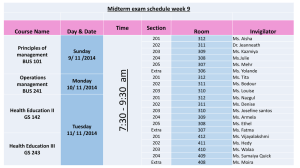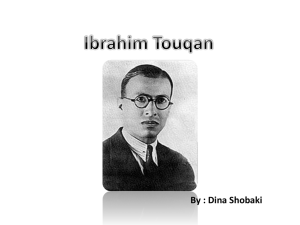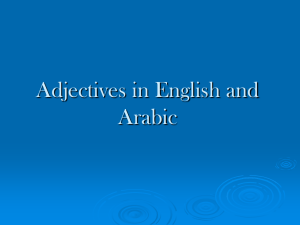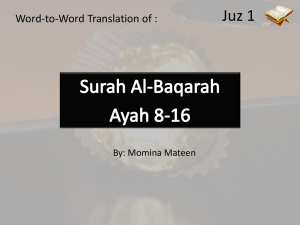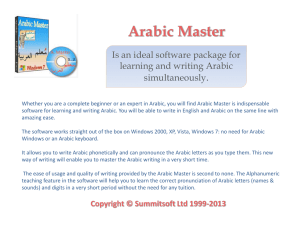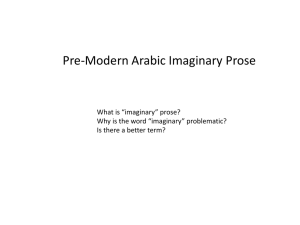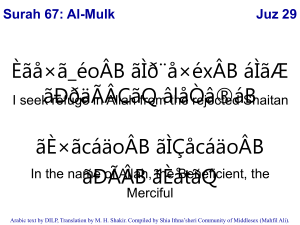Welcome to Arabic
advertisement
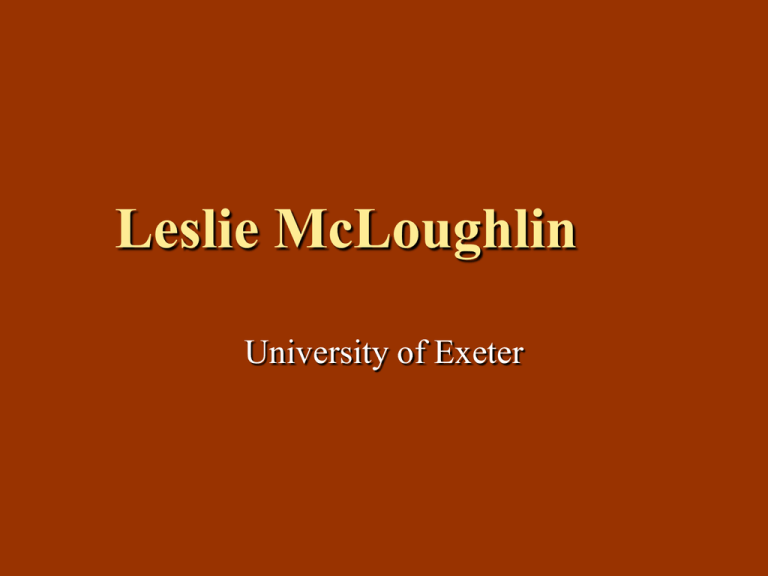
Leslie McLoughlin University of Exeter WELCOME TO ARABIC!! تعلموا وتزيد في المروءة، فإنها تثبت القلوب،اللغة العربية Abu Muslim Al-Basri,quoting the Caliph Umar,7th century AD “Learn the Arabic language since it gives hearts endurance and increases [manly] virtue.” Wisdom has alighted on three things:the brain of the Franks,the hands of the Chinese and the tongue of the Arabs (P.K.Hitti,History of the Arabs,10th ed.,p. 91) The beauty of man lies in the eloquence of his tongue…….. Arabic-speaking countries Arabic and Islam In the name of the Most Compassionate, the Most Merciful The Arab League:22 states Arabic in the Modern World Arabic is spoken as the first or second language by some 325 million people Modern Written Arabic is the direct descendant of Classical Arabic,of which the first model was the Holy Koran: both versions use practically the same grammar,vocabulary and writing system Arabic is one of the 6 working languages of the United Nations Written Arabic is uniform in all countries of the Arab League The language of radio and television is simply the spoken form of Written Arabic This media language is sometimes called Modern Standard Arabic and is also used widely in teaching in schools and universities It can be used conversationally between Arabs from widely separated areas,for instance between a Moroccan and a Kuwaiti Spoken Standard Arabic can also be of use for non-Arabs coming to an area whose dialect is unfamiliar to them Arabs normally speak the dialect they grew up with and have no complexes such as are found in British English (Think of “My Fair Lady”,Pygmalion and Professor Higgins…..) Dialect or colloquial Arabic is never written ,except for comic effect. Arabic at Exeter You will become familiar with Classical Arabic Modern Written Arabic Standard Spoken Arabic One or more dialects The Year Abroad is spent in one of several dialect areas,e.g. Syria,Egypt,Yemen All you need to know about Arabic before you start Arabic is a Semitic language,i.e. of the family of Hebrew and Aramaic but not of the same familiy as Farsi,Turkish or Kurdish The main feature of Semitic languages is the 3-letter root system: i.e. s-l-m means “peace” in Arabic (salaam) and sh-l-m means “peace” in Hebrew(shalom) Arabic’s main feature is the root-and-pattern system where a pattern is imposed on the basic root: thus sa/ll/ama means : “to say “Peace” to someone” Patterns have a predictable meaning:the pattern /aa-/i means “the person doing the action”.And so..if k/t/b has to do with “writing”, k/aa/ti/b must mean: “author,writer,scribe,clerk manuensis,writer,notary,scrivener” etc. This also shows that Arabic is very economical in its vocabulary You will find that your Arabic vocabulary will grow very rapidly once you understand the root-and-pattern system The grammar of Arabic is based on logic ,economy and consistency All of the above applies to both spoken and written Arabic So….why does everyone think that Arabic is uniquely difficult? Arabic is entirely surrounded by myths You must clear your mind of these before starting What are these myths? Myths about Arabic The script is impossibly difficult,like hieroglyphics. Nonsense: it is a cursive alphabet of 28 letters,written right to left,which for many is easier than left to right as it involves pushing the pen ,not pullling it. Arabic has too many exotic sounds,impossible for foreigners. Garbage: there are only 2 or 3 which are not found in English and these can be learned through imitation. Arabic has a terribly rich vocabulary,400 words for the camel,200 for the lion etc. Rubbish: that is true only of ancient poetry.English vocabulary is in many ways much richer.(Remember “writer,scribe etc.” in Slide 9 Arabic grammar is fiendishly complicated. Piffle: its verb system is far easier than English.Just two tenses – past and non-past. You will now learn how to count in Arabic and how to write Arabic.
